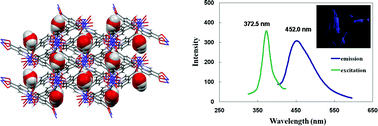Two-dimensional metal–organic frameworks with blue luminescence†
Abstract
Three new isostructural two-dimensional metal–organic frameworks (MOFs), [M(bpydc)(H2O)·H2O]n where M =

* Corresponding authors
a Department of Chemistry and Protein Research Center for Bio-Industry, Hankuk University of Foreign Studies, Yongin, Korea
b
Department of Chemistry, Center for NanoBio Applied Technology, and Institute of Basic Sciences, Sungshin Women's University, Seoul, Korea
E-mail:
spark@sungshin.ac.kr
Fax: 82 2 920 2047
Tel: 82 2 920 7646
c Department of Chemistry and Nano Science, Ewha Womans University, Seoul, Korea
Three new isostructural two-dimensional metal–organic frameworks (MOFs), [M(bpydc)(H2O)·H2O]n where M =

 Please wait while we load your content...
Something went wrong. Try again?
Please wait while we load your content...
Something went wrong. Try again?
S. Huh, S. Jung, Y. Kim, S. Kim and S. Park, Dalton Trans., 2010, 39, 1261 DOI: 10.1039/B916176G
To request permission to reproduce material from this article, please go to the Copyright Clearance Center request page.
If you are an author contributing to an RSC publication, you do not need to request permission provided correct acknowledgement is given.
If you are the author of this article, you do not need to request permission to reproduce figures and diagrams provided correct acknowledgement is given. If you want to reproduce the whole article in a third-party publication (excluding your thesis/dissertation for which permission is not required) please go to the Copyright Clearance Center request page.
Read more about how to correctly acknowledge RSC content.
 Fetching data from CrossRef.
Fetching data from CrossRef.
This may take some time to load.
Loading related content
